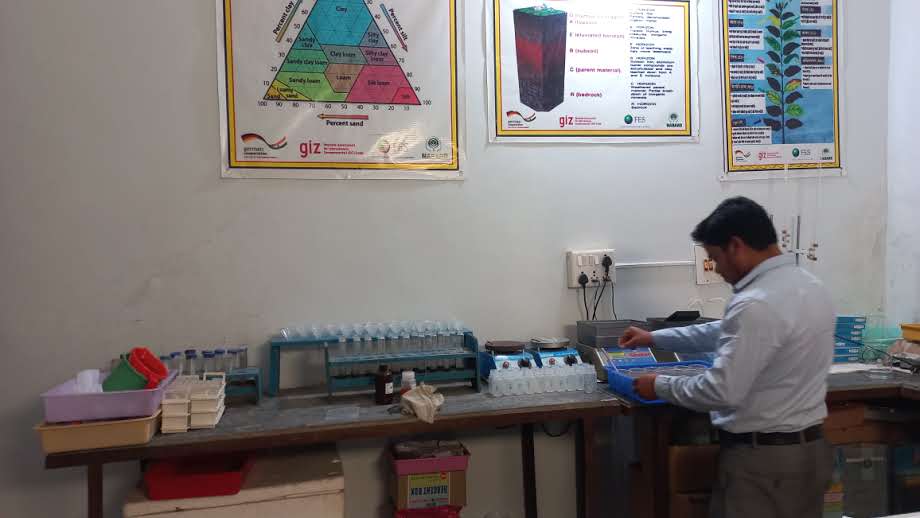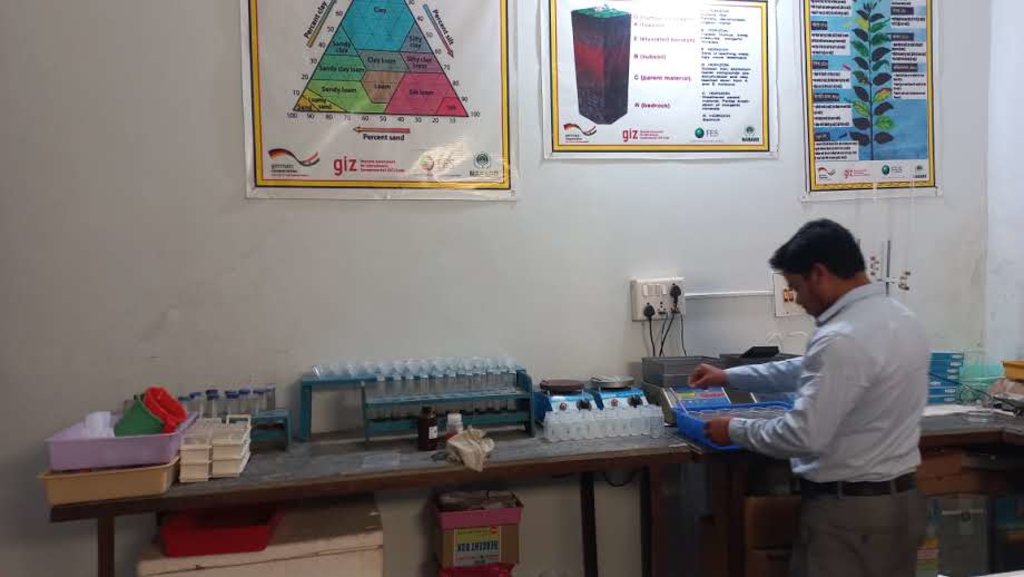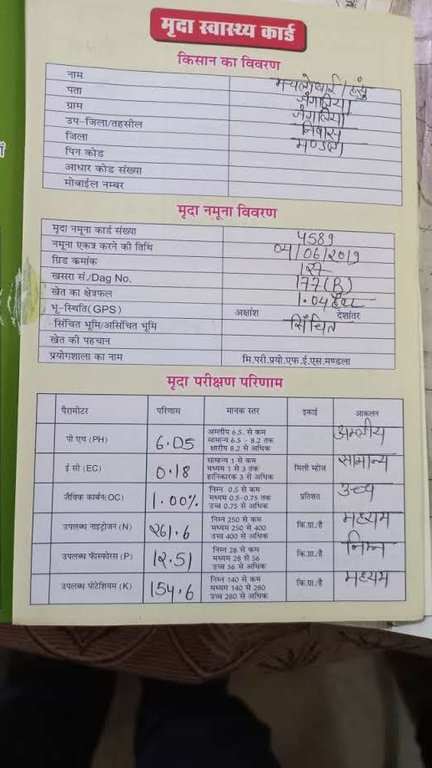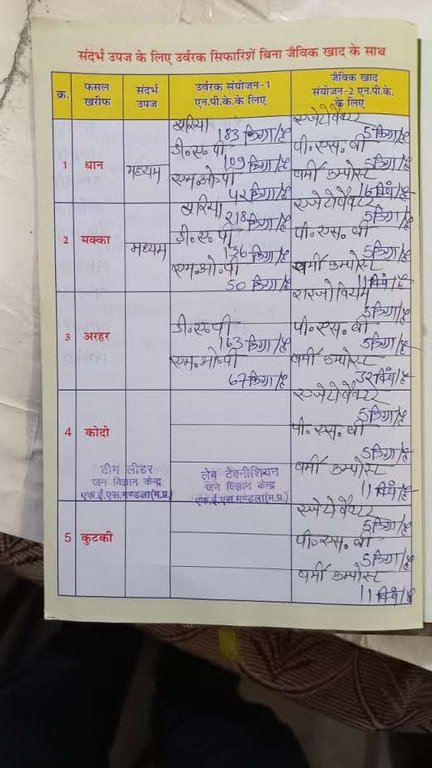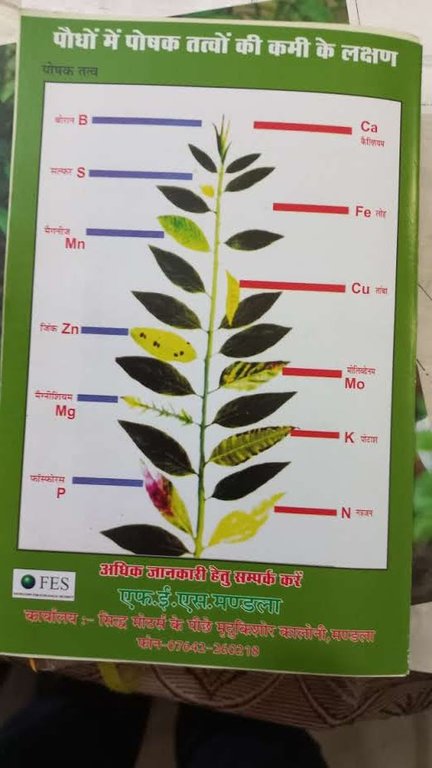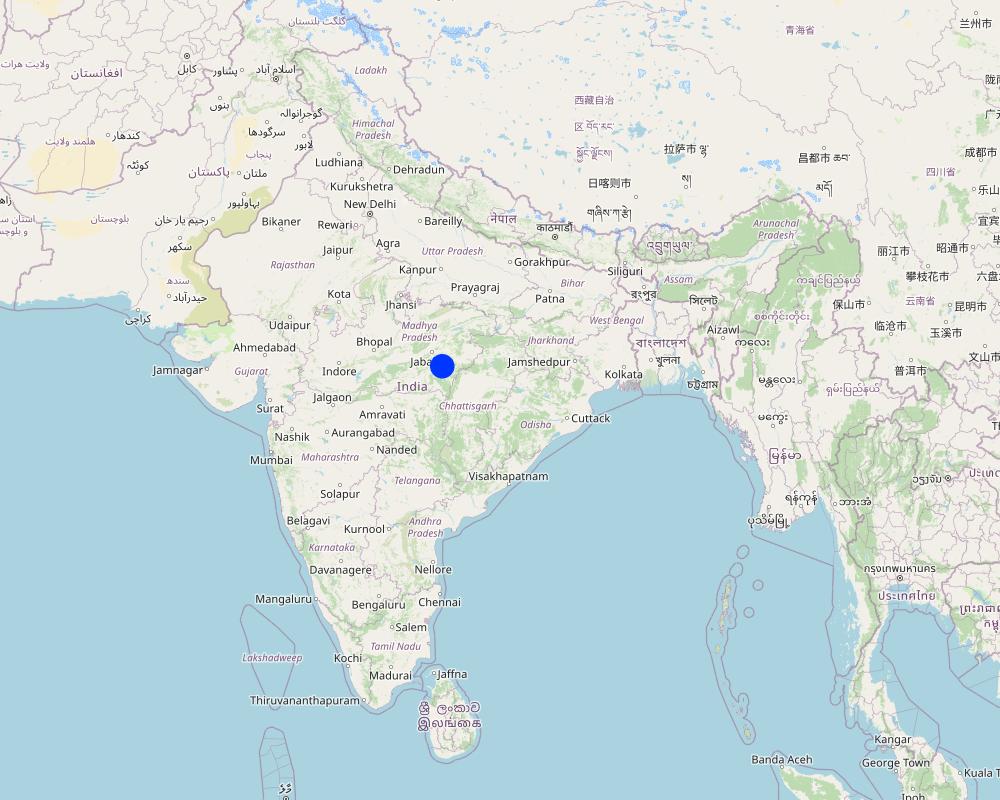Dissemination of Soil Test Results to Farmers through a Participatory Approach [India]
- Creation:
- Update:
- Compiler: Santosh Gupta
- Editors: Noel Templer, Stephanie Katsir, Tabitha Nekesa, Ahmadou Gaye, Siagbé Golli
- Reviewers: Udo Höggel, Joana Eichenberger, Sally Bunning
Mitti ki namuna
approaches_6698 - India
- Full summary as PDF
- Full summary as PDF for print
- Full summary in the browser
- Full summary (unformatted)
- Dissemination of Soil Test Results to Farmers through a Participatory Approach: June 18, 2023 (inactive)
- Dissemination of Soil Test Results to Farmers through a Participatory Approach: Sept. 14, 2023 (inactive)
- Dissemination of Soil Test Results to Farmers through a Participatory Approach: April 11, 2024 (public)
View sections
Expand all Collapse all1. General information
1.2 Contact details of resource persons and institutions involved in the assessment and documentation of the Approach
Name of project which facilitated the documentation/ evaluation of the Approach (if relevant)
Soil protection and rehabilitation for food security (ProSo(i)l)Name of the institution(s) which facilitated the documentation/ evaluation of the Approach (if relevant)
Deutsche Gesellschaft für Internationale Zusammenarbeit (GIZ)Name of the institution(s) which facilitated the documentation/ evaluation of the Approach (if relevant)
CIAT International Center for Tropical Agriculture (CIAT International Center for Tropical Agriculture) - KenyaName of the institution(s) which facilitated the documentation/ evaluation of the Approach (if relevant)
Ecociate Consultants (Ecociate Consultants) - India1.3 Conditions regarding the use of data documented through WOCAT
When were the data compiled (in the field)?
22/02/2023
The compiler and key resource person(s) accept the conditions regarding the use of data documented through WOCAT:
Yes
2. Description of the SLM Approach
2.1 Short description of the Approach
A systematic approach has been developed under the project for collecting soil samples, conducting the soil test results, issuing soil health cards, building the capacity of farmers to interpret the soil health card and apply the required nutrients to the soil based on the soil test result
2.2 Detailed description of the Approach
Detailed description of the Approach:
Soil testing is a pre-cultivation activity that gives a good idea about soil structure and mineral composition ratios. The essential nutrients required for various crop growths can be estimated during soil testing. The Foundation for Ecological Security (FES) has established a state-of-the-art soil testing laboratory for testing soil samples in India's Mandla District of Madhya Pradesh. The soil test lab was established in 2016 with a capacity to test 1500-2000 soil samples every year. Based on a soil sampling process, it takes around 2 days to generate the soil test results for 20 soil samples. Collected soil samples are tested for 12 parameters. These parameters include Soil Ph, Soil organic carbon (SoC), electrical conductivity (EC), major nutrients like nitrogen(N), phosphorus (P), potassium (K), secondary nutrients like sulphur, magnesium, iron, boron, zinc, manganese, and copper. Based on the soil test report, farmers are issued a soil health card with crop-specific recommendations for additional chemical and organic inputs into the soil.
To ensure the accuracy of the sampling process and proper dissemination of generated results among the farmers, FES has developed a very systematic process which consists of:
•the collection of soil samples
•the analysis of collected soil samples in an FES lab
•the issuance of soil health cards
•the interpretation of soil test results
•noticing of test results to farmers
•farmers are able to implement practices, recommended by the test result
The entire process, from soil sampling to dissemination, is briefly mentioned below:
•Developing the grids for a random collection of soil samples: The first step is to develop a geographical grid for collecting random samples based on predefined parameters. In the irrigated areas, samples are drawn in a grid of 2.5 ha, while in rainfed areas, samples are drawn from a grid of 10 ha. While developing the grid, farmers' fields are categorized into the following parameters. Each of the parameters is assigned a specific score, and based on the obtained score, each farmer’s land is given a specific number for easy identification on soil maps. These include the a) type of soil, b) type of field, e.g., upland, medium land, or low land, c) crop cycle (Single crop, multiple crops) d) The slope of the field. This entire exercise is a soil survey exercise used to develop soil maps for each geographical unit village, block, district.
•Collection of soil samples: From each classified grid, soil samples are collected from 5 different locations between the harvest of one crop and the sowing/planting of another crop when fields are vacant. The soil samples are collected at a depth of 5 to 15 cm. All the collected soil samples are mixed repeatedly, and a portion of the collected soil is kept aside each time. The mixing process is followed 5-6 times to ensure collected soil samples represent the entire area. Finally, around 500 gm of soil is packed in plastic polythene based on the above grid parameters.
•Soil sample analysis: Collected soil samples are transported to the centralized soil test lab in Mandla (MP) for testing and analysis. The samples are analyzed by qualified lab personnel. The analysis process for the above mentioned 12 parameters takes around 2 days (considering 8-9 working hours in a day).
•Issuance of soil health card: Based on the results obtained from the analysis, soil health cards are issued to farmers. The soil health card contains the following information in the local language (Hindi) so that farmers understand the test results and their implications:
a.Basic details of the farmer: name, address, soil grid, GPS coordinates, field identification number, etc.
b.Soil test results for above mentioned 12 parameters: results of the soil test in their respective units, standard numbers, grading of the obtained result (acidic/saline for PH., high, medium, low for other parameters)
c.Crop-wise soil correction recommendations for major crops: recommendations for synthetic fertilizers, biofertilizers, and compost
d.Pre-printed information with photos for identification of nutrient deficiency in the crops.
•Dissemination of soil health card to farmers: To ensure that farmers understand the results and implement the practices at their field, local community resource persons reach out to every farmer to make them understand the soil test results and closely monitor their farmers’ practices across the crop stages. Farmers are also encouraged to maintain farm diaries for their practices. They are also trained in the preparation of various bio-inputs and compost for application in their field.
2.3 Photos of the Approach
General remarks regarding photos:
All the photos have been taken at the soil test lab of the FES.
2.5 Country/ region/ locations where the Approach has been applied
Country:
India
Region/ State/ Province:
Madhya Pradesh
Further specification of location:
Mandla
Comments:
Mandla, Madhya Pradesh, India
Map
×2.6 Dates of initiation and termination of the Approach
Indicate year of initiation:
2018
2.7 Type of Approach
- project/ programme based
2.8 Main aims/ objectives of the Approach
1. Ensure judicious usage of fertilizers and micronutrients based on the requirement of the soil
2. Ensure quality soil testing and dissemination of results
3. Build farmers' capacity for interpretation of soil health cards
4. Develop soil maps based on the in-house results from the soil test lab
2.9 Conditions enabling or hindering implementation of the Technology/ Technologies applied under the Approach
institutional setting
- enabling
The entire dissemination methodology is done through community-based organizations
collaboration/ coordination of actors
- enabling
Several stakeholders, such as FES, farmers, equipment suppliers, the scientific community, and soil scientists, are involved in the project
policies
- enabling
Soil test results are an excellent input for the agricultural policies around fertilizers, farming practices, and soil health-related policies
land governance (decision-making, implementation and enforcement)
- enabling
A soil health card is an excellent tool for farmers to decide on the usage of fertilizers and the kind of farming practices to implement
knowledge about SLM, access to technical support
- enabling
Soil health cards inform the farmers and the project management team so to decide on required interventions and farming practices
markets (to purchase inputs, sell products) and prices
- enabling
Very much relevant as soil test results quantify the number of farm inputs to be applied to the farm
3. Participation and roles of stakeholders involved
3.1 Stakeholders involved in the Approach and their roles
- local land users/ local communities
Farmers from the project area
Soil samples were collected from the field of farmers. They have actively participated in the projects for managing the soil samples, participating in the capacity building programs, and implementing the recommended practices.
- community-based organizations
FES, the implementing NGO, have formed the Villages Environment Committee (VEC) in their project villages as community-based organizations
VECs facilitated the implanting of a project by mobilizing the communities as and when needed. FES reached farmers through the VECs, to collect the soil samples or disseminate the information. VECs also facilitated community-level implementation activities.
- SLM specialists/ agricultural advisers
SLM Specialist
Documentation of the activities
- NGO
Foundation for Ecological Security (FES) is a well-known NGO registered in India. It focuses on ecology-related issues and works closely with farmers and forest-based communities.
FES played an essential role in the project. Primary activities were as follows:
1. Establishment of soil testing laboratory and hiring the technical team to conduct the soil test lab
2. Collection of soil test samples and building the capacity of farmers on soil sample collection
3. Conducting soil test results and issuance of soil health cards to farmers
4. Developing a soil health map for the project areas
5. Capacity building of farmers for the interpretation of soil health cards and ensuring the implementation of recommended practices
- international organization
GIZ, India
Funding of the project
If several stakeholders were involved, indicate lead agency:
Foundation for Ecological Security
3.2 Involvement of local land users/ local communities in the different phases of the Approach
| Involvement of local land users/ local communities | Specify who was involved and describe activities | |
|---|---|---|
| initiation/ motivation | passive | The FES led the initiation of discussions with its donor organizations. Discussions with communities to understand the challenges and opportunities. |
| planning | interactive | Local community institutions played a significant role in the entire process of planning and execution |
| implementation | interactive | Farmers and community-based institutions were actively involved in implementing multiple activities under the project, such as collecting soil samples, supplying them to the soil test labs, and Implementing the recommended practices. |
| monitoring/ evaluation | interactive | Community-based institutions played an important role in monitoring individual farmers for implementing the recommendations provided to farmers. They also monitored the results regarding crop progress, crop productivity, and improvement in soil health status. |
3.4 Decision-making on the selection of SLM Technology/ Technologies
Specify who decided on the selection of the Technology/ Technologies to be implemented:
- all relevant actors, as part of a participatory approach
Explain:
All actors, including the farmers, CBO, NGO, and soil scientists, mutually discussed and decided on the implementation of technology as all stakeholders were equally crucial for the effective and result-oriented implementation of the technology.
Specify on what basis decisions were made:
- evaluation of well-documented SLM knowledge (evidence-based decision-making)
- research findings
4. Technical support, capacity building, and knowledge management
4.1 Capacity building/ training
Was training provided to land users/ other stakeholders?
Yes
Specify who was trained:
- land users
- field staff/ advisers
If relevant, specify gender, age, status, ethnicity, etc.
Both male and female farmers in all age groups were trained under the project. The majority of the farmers were from tribal communities.
Form of training:
- farmer-to-farmer
- demonstration areas
- public meetings
Subjects covered:
1. Importance of soil testing for the judicious use of fertilizers
2. Methods for soil sample collection
3. Interpretation of soil health card
4. Dissemination of soil test results and ways and means for implementing the recommended practices following organic and non-organic implementation practices
4.2 Advisory service
Do land users have access to an advisory service?
Yes
Specify whether advisory service is provided:
- on land users' fields
Describe/ comments:
FES has a team of community-based resource persons from the local community and villages to provide advisory services to farmers
4.3 Institution strengthening (organizational development)
Have institutions been established or strengthened through the Approach?
- yes, greatly
Specify the level(s) at which institutions have been strengthened or established:
- local
Describe institution, roles and responsibilities, members, etc.
Village-level environment committees were formed to discuss the issues related to environmental concerns, livelihoods, and other social problems at the village level. These committees consist of male and female members representing the entire village.
Specify type of support:
- financial
- capacity building/ training
Give further details:
These committees were provided financial support to implement the identified activities based on the provision under the project and proposals submitted by the local committees. FES regularly provides training and handholding support to these committees.
4.4 Monitoring and evaluation
Is monitoring and evaluation part of the Approach?
Yes
Comments:
The soil health report card is very useful in monitoring of the status of soil health and measuring the impact of various practices and intervention
If yes, is this documentation intended to be used for monitoring and evaluation?
No
4.5 Research
Was research part of the Approach?
Yes
Specify topics:
- ecology
- technology
5. Financing and external material support
5.1 Annual budget for the SLM component of the Approach
If precise annual budget is not known, indicate range:
- 2,000-10,000
Comments (e.g. main sources of funding/ major donors):
Externally funded projects (GIZ)
5.2 Financial/ material support provided to land users
Did land users receive financial/ material support for implementing the Technology/ Technologies?
No
5.3 Subsidies for specific inputs (including labour)
- equipment
| Specify which inputs were subsidised | To which extent | Specify subsidies |
|---|---|---|
| machinery | partly financed | Different equipment used for testing the soils |
| tools | partly financed | Different tools are used for collecting soil samples and for soil testing |
If labour by land users was a substantial input, was it:
- voluntary
5.4 Credit
Was credit provided under the Approach for SLM activities?
No
5.5 Other incentives or instruments
Were other incentives or instruments used to promote implementation of SLM Technologies?
No
6. Impact analysis and concluding statements
6.1 Impacts of the Approach
Did the Approach enable evidence-based decision-making?
- No
- Yes, little
- Yes, moderately
- Yes, greatly
Soil health card-based changes in soil management and developing the evidence for soil health monitoring
Did the Approach improve coordination and cost-effective implementation of SLM?
- No
- Yes, little
- Yes, moderately
- Yes, greatly
Reduced the cost of applying fertilizers and other inputs through a result-based application
Did the Approach improve knowledge and capacities of land users to implement SLM?
- No
- Yes, little
- Yes, moderately
- Yes, greatly
Training and handholding by the team of implementing partners have helped land users to interpret the result of soil health card, collection of soil samples and following the recommended practices
Did the Approach improve knowledge and capacities of other stakeholders?
- No
- Yes, little
- Yes, moderately
- Yes, greatly
Other stakeholders such as implementing team got information about the outcome of their practices. More importantly, the soil health card was helpful in providing precise information on the application of fertilisers and bio-inputs.
Did the Approach encourage young people/ the next generation of land users to engage in SLM?
- No
- Yes, little
- Yes, moderately
- Yes, greatly
Youths were greatly involved in collection of soil samples
6.2 Main motivation of land users to implement SLM
- increased profit(ability), improved cost-benefit-ratio
With soil test results, land users now need to apply only the required nutrients in a specific quantity. This reduced the cost of soil management and fertilisers.
- reduced land degradation
Soil test results were helpful in preventing and reducing the non-judicious usage of synthetic fertilisers, which was among the major reasons for land degradation in the project area. Also recommendations for both organic and synthetic fertilisers based on the soil health cards helped farmers in replacing synthetic fertilisers with organic fertilisers.
- environmental consciousness
6.3 Sustainability of Approach activities
Can the land users sustain what has been implemented through the Approach (without external support)?
- yes
If yes, describe how:
Yes. The benefit in both reduced cost and improved soil health are the triggers to sustaining the practices. Also, the involvement of local community institutions will also ensure the sustainability of interventions.
6.4 Strengths/ advantages of the Approach
| Strengths/ advantages/ opportunities in the land user’s view |
|---|
| Judicious use of fertilizers and pesticides based on the nutrient requirement of soil, as mentioned under the soil health report |
| Separate recommendations for both chemical and organic (bio-inputs) are a good way for land users to make informed decisions |
| Tracing the improvement in soil health status based on the land users' agricultural practices |
| Strengths/ advantages/ opportunities in the compiler’s or other key resource person’s view |
|---|
| Developing the soil maps for the entire area to design appropriate interventions for the project |
| Instead of general recommendations for input application, the soil health card helped develop farmer/village-centric extension services for the farmers |
| Understand the impact of various interventions through periodic soil testing to document what has worked and what has not. Even this evidence can be used to monitor the soil organic carbon content for designing carbon-based projects and/or to access national or international carbon reduction credits. |
6.5 Weaknesses/ disadvantages of the Approach and ways of overcoming them
| Weaknesses/ disadvantages/ risks in the land user’s view | How can they be overcome? |
|---|---|
| Farmers are still unaware of the soil test facility and its benefits | Regular awareness programs along with a demonstration of soil sample collection |
| Weaknesses/ disadvantages/ risks in the compiler’s or other key resource person’s view | How can they be overcome? |
|---|---|
| Farmers' strong belief in the application of a certain quantity of fertilizers to ensure better production | This requires specific behavior change campaigns through local demonstration and documentation |
| Government authorities also conduct the soil test and issue the soil health card. However the farmers' experience with such system has not been outstanding. | Put efforts into conveying the difference between both approaches by promptly issuing the soil health card |
| The soil test lab is in the District capital, so farmers in far-away areas may face difficulties in accessing the facility | Explore the option of establishing soil test labs near farmers' locations |
7. References and links
7.1 Methods/ sources of information
- field visits, field surveys
1
- interviews with land users
5
- interviews with SLM specialists/ experts
2
- compilation from reports and other existing documentation
3
7.3 Links to relevant information which is available online
Title/ description:
Operational Guidelines for implementation of CENTRALLY SPONSORED SCHEME SOIL HEALTH CARD
URL:
https://agricoop.nic.in/sites/default/files/GSHC3.pdf
Links and modules
Expand all Collapse allLinks
No links
Modules
No modules


